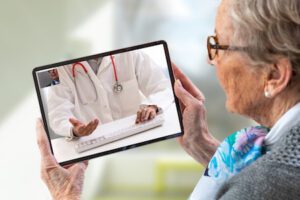
The Rise of Telemedicine: Navigating the New Era of Healthcare
The digital revolution has touched every corner of our lives, and the medical world is no exception. Over the past decade, telemedicine, or telehealth, has seen an explosive rise, reshaping the landscape of healthcare. From its early beginnings to the booming industry it is today, let’s delve deep into the world of telemedicine.
A Glimpse into the Past: The Beginnings of Telemedicine
While it might seem like a modern innovation, the concept of telemedicine has its roots in the early 20th century. When radios and telephones became household items, some physicians imagined a world where consultations could happen over the airwaves. Fast forward to the 1960s, and with the advent of the internet and video conferencing, the seeds of modern telehealth were planted.
The Digital Revolution: A Boon for Healthcare
The rise of the smartphone and pervasive internet connectivity made telehealth more accessible than ever. Patients could now connect with healthcare professionals without the constraints of physical location. This democratization of access was especially beneficial for those in remote or underserved areas, where specialized medical care was hard to come by.

Diverse Avenues: The Various Forms of Telemedicine
The concept of telemedicine is not monolithic. Over the years, it has branched out to cater to different needs, specialties, and circumstances. As medical practices adapt to the digital age, understanding the distinct forms of telemedicine becomes crucial. Here’s a comprehensive look at the different types and what they entail.
1. Real-Time Interactive Telemedicine
This is perhaps what most people envision when they think of telemedicine. It involves a live interaction between a patient and a healthcare provider. Typically, this is done via video conferencing, but it can also include phone calls for consultations.
Applications: Routine check-ups, mental health counseling, post-operative follow-ups, and more.
2. Store-and-Forward Telemedicine (Asynchronous)
Store-and-forward telemedicine does not require the patient and the provider to be present at the same time. Instead, medical data such as lab results, images, and videos are collected and then sent to a specialist for review at a later time.
Applications: Radiology, dermatology, and pathology, where in-depth analysis of medical images and data is essential.
3. Remote Patient Monitoring (RPM)
RPM allows healthcare providers to monitor a patient’s vitals and other health data from a distance. This is particularly beneficial for patients with chronic diseases, as it provides continuous data without them having to frequently visit a healthcare facility.
Applications: Monitoring blood pressure for hypertensive patients, glucose monitoring for diabetics, heart rate monitoring for cardiac patients, and more.
4. Mobile Health (mHealth)
This involves the use of mobile devices and apps to promote health and wellness. From fitness trackers to medication reminder apps, mHealth is an expansive field that bridges the gap between traditional healthcare and the digital age.
Applications: Patient education, health tracking, medication reminders, and health data collection.
5. Teleradiology
This is one of the earliest forms of telemedicine. It involves the electronic transmission of radiological images from one location to another for interpretation by a radiologist.
Applications: MRI, CT scans, X-rays, and ultrasound images.
6. Telepsychiatry
Mental health is an area that has significantly benefited from telemedicine. Telepsychiatry connects patients with psychiatrists or therapists via video conferencing, making mental health services more accessible.
Applications: Counseling sessions, psychiatric evaluations, therapy sessions, and patient education.
7. Teledermatology
This allows dermatologists to review skin conditions without an in-person visit. Patients can send pictures of their skin conditions, which dermatologists can then diagnose and prescribe treatment for.
Applications: Diagnosing skin conditions like eczema, psoriasis, and various forms of dermatitis.

The Multifaceted World of Telemedicine
Telemedicine is not just a singular approach to healthcare; it’s an amalgamation of various methods, each tailored to specific needs. As the digital transformation of healthcare continues, these forms of telemedicine will play a pivotal role in ensuring healthcare is accessible, efficient, and patient-centric. The future is undeniably digital, and understanding the breadth and depth of telemedicine is a step forward in adapting to this new era.
Benefits of Telemedicine
- Accessibility: For those with mobility challenges, or those living in remote areas, telemedicine bridges the gap, ensuring they don’t miss out on crucial healthcare services.
- Flexibility: Telehealth appointments can often be scheduled outside of traditional office hours, allowing patients to fit their consultations around their lives.
- Cost-Efficiency: By eliminating the need to travel and reducing overheads for medical professionals, telemedicine can lead to cost savings for both patients and providers.
- Reduced Exposure: Especially relevant in the age of contagious diseases, virtual appointments mean reduced risk of spreading or contracting illnesses.
Why Telemedicine is Reshaping Healthcare
The rise of telemedicine is not just due to technological advances but is deeply rooted in its vast benefits for both patients and healthcare providers. As medical practitioners and institutions adopt telehealth solutions, they’re beginning to witness a profound positive impact on patient care, operational efficiency, and overall healthcare accessibility. Here’s a comprehensive analysis of why telemedicine is in such high demand:
Patient-Centric Advantages
1. Convenience and Comfort Patients no longer need to take time off work, travel long distances, or sit in waiting rooms. With telemedicine, they can consult with their healthcare providers from the comfort of their homes, making medical care more convenient and less disruptive to their daily routines.
2. Reduced Costs Traveling to a clinic or hospital involves costs – fuel, public transport, parking fees, or even potential accommodation for those traveling from afar. Telemedicine eliminates these expenses, making healthcare more affordable.
3. Access to Specialists For patients in remote or underserved areas, getting access to specialists can be a challenge. Telemedicine bridges this gap, allowing patients to consult with experts that they might not have been able to see otherwise.
4. Minimized Exposure to Illnesses Visiting a healthcare facility exposes patients to other sick individuals. This is particularly concerning for those with compromised immune systems. With virtual consultations, this risk is negated.

Elevating Healthcare Accessibility
1. Reaching Remote Locations Rural areas often lack comprehensive medical facilities. Telemedicine extends the reach of healthcare, ensuring that even those in the most remote locations can access quality medical care.
2. Overcoming Shortage of Healthcare Professionals There’s a global shortage of healthcare professionals, especially in rural settings. Telemedicine helps in decentralizing healthcare, allowing professionals in one location to serve patients in multiple areas.
3. Flexibility in Scheduling Traditional healthcare often operates within strict working hours. However, telemedicine can offer more flexibility, with some services being available round the clock, ensuring patients get care precisely when they need it.
4. Efficient Use of Resources For healthcare providers, telemedicine can lead to a more efficient use of resources. For instance, quick consultations can be done online, freeing up space and time for patients who need in-person care.
5. Enhanced Patient Engagement Telemedicine platforms often come with features like chatbots, reminders, and health trackers. These tools keep patients engaged with their health, leading to better outcomes.
Telemedicine as the Future of Healthcare
Telemedicine offers a harmonious blend of convenience and efficiency, making it a pivotal tool in modern healthcare. For patients, it means better access and more comfortable experiences. For providers, it’s about extending their reach and optimizing resources. As the lines between technology and healthcare continue to blur, the importance of telemedicine in shaping the future of patient care cannot be overstated.
Challenges Facing Telemedicine
However, like any transformative change, telemedicine comes with its set of challenges:
- Technical Difficulties: Not all patients have access to stable internet connections or the necessary devices.
- Security Concerns: Digital consultations raise questions about data privacy and the security of patient information.
- Regulation and Licensing: Navigating the complex web of healthcare regulations across states and countries can be tricky.
- Clinical Limitations: While many conditions can be diagnosed remotely, certain ailments still require in-person examinations.
Technical Challenges
Barrier: Not all patients are tech-savvy, especially older generations. They may struggle with the technical aspects of telemedicine platforms, leading to potential hesitancy in adoption.
Solution: Medical practices can offer training sessions or tutorials for patients. Clear instructions, easy-to-navigate platforms, and dedicated helplines can alleviate technological anxieties and smoothen the transition.
Connectivity Concerns
Barrier: Stable internet connectivity is crucial for effective telemedicine consultations. In some remote areas, connectivity can be spotty, leading to disrupted sessions.
Solution: Providers can look into partnering with local internet service companies to offer solutions or discounts. Additionally, some telemedicine platforms have low-bandwidth modes to accommodate slower internet speeds.
Privacy and Security
Barrier: Telehealth solutions involve the transmission of sensitive patient data over the internet, raising concerns about data breaches and privacy infringements.
Solution: Practices should prioritize platforms with robust security features, such as end-to-end encryption and HIPAA compliance. Regular security audits and training sessions for staff on data protection principles are also essential.

Licensing and Regulatory Hurdles
Barrier: Medical licensing often operates on a state-by-state basis. A doctor licensed in one state might not be permitted to offer telehealth services to a patient in another.
Solution: Medical boards and associations are increasingly recognizing this challenge. Some states have introduced telemedicine reciprocity agreements, allowing cross-border consultations. Practices should stay updated on such regulatory changes and adjust their services accordingly.
Building Rapport Virtually
Barrier: A significant part of healthcare revolves around the personal touch, the rapport between doctor and patient. Some healthcare providers feel that the virtual nature of telemedicine makes it challenging to build that connection.
Solution: Training sessions on virtual communication can be beneficial. It’s essential to maintain eye contact, actively listen, and ensure the patient feels seen and heard, even in a virtual setting. Periodic in-person meetings, when feasible, can also help maintain the doctor-patient relationship.
Overcoming Reimbursement Issues
Barrier: Traditionally, reimbursement models haven’t always favored telemedicine, leading to financial concerns for providers.
Solution: This is rapidly changing, with more insurance companies recognizing the value of telehealth. Medical practices should maintain open lines of communication with insurance providers and be aware of evolving reimbursement structures.
A Proactive Approach is Key
While the challenges of telemedicine are real, they are by no means insurmountable. The future of healthcare is inevitably intertwined with technology. By understanding these challenges and proactively seeking solutions, medical practices can position themselves at the forefront of this evolution, delivering care that’s not just efficient and accessible, but also compassionate and patient-centric.
The Future of Telemedicine
The global health crisis brought about by COVID-19 turbocharged the adoption of telehealth. With people hesitant to visit clinics and hospitals for fear of infection, virtual consultations became the norm. This rapid adoption has led to more innovations and investments in the sector.
Moving forward, we can expect to see:
- Integration with Wearable Tech: As wearable health tech becomes more advanced, real-time data can be shared with healthcare providers during consultations.
- AI-Powered Diagnostics: Artificial intelligence could help in preliminary diagnosis, making virtual consultations even more efficient.
- Expansion of Services: Beyond consultations, telehealth platforms might offer a range of services, from mental health support to post-operative care.
As we peer into the future of healthcare, it’s evident that telemedicine is not merely a temporary solution or a passing trend. It’s poised to reshape how medical care is delivered, driven by technological advancements, patient demand, and a shifting healthcare paradigm. Here’s a glimpse into what the telemedicine-driven future might look like and why in-person appointments could become less frequent.

Expanding Range of Services
Tele-specialty Care: As telemedicine platforms become more sophisticated, we’ll likely see an expansion in the range of specialties offered. From psychiatry to dermatology and even some surgical consults, the scope of telehealth will grow, ensuring patients have access to a wider range of specialists without the need for travel.
AI and Machine Learning Integration
The integration of artificial intelligence (AI) and machine learning into telemedicine platforms will drive more personalized patient care. These technologies can assist in preliminary diagnoses, monitor patient health trends, and even predict potential health issues based on data, ensuring timely interventions.
Wearable Tech Collaboration
As wearable health tech devices like smartwatches and fitness trackers become more advanced, they will seamlessly integrate with telehealth platforms. This will allow continuous monitoring and real-time data sharing between patients and doctors, enabling more proactive healthcare and reducing the need for regular in-person check-ins.
Virtual Health Assistants
Imagine having a virtual health assistant available 24/7, guiding patients on basic health queries, medication dosages, or even mental health exercises. Such advances will reduce the pressure on healthcare systems and ensure patients have round-the-clock guidance, further decreasing the frequency of physical visits.
Global Healthcare Access
One of the most transformative impacts of telemedicine will be its role in democratizing healthcare access. Patients in remote or underserved areas globally will have access to world-class specialists, leveling the playing field and ensuring quality healthcare is a universal right, not a privilege.
Emphasis on Preventative Care
With easier access to medical consultations, there will be a pronounced shift towards preventative care. Regular virtual check-ups, health monitoring, and early interventions will become the norm, reducing the incidence of severe health issues that necessitate in-person visits.
Challenges to Overcome
Despite its promise, the move towards a predominantly telemedicine-driven model won’t be without its challenges. Issues like data privacy, ensuring the human touch in medicine, and global regulatory standardization will need to be addressed. However, with collaborative effort, these hurdles can be navigated.
While in-person appointments will never vanish entirely—certain conditions and treatments will always require a hands-on approach—the scales are tipping in favor of virtual healthcare. The benefits of convenience, access, and efficiency are undeniable. As we stand on the cusp of this new era, it’s exciting to imagine a world where quality healthcare is just a click away, ensuring everyone, no matter where they are, has the opportunity to lead a healthier, happier life.

Telemedicine and Healthcare Jobs: Evolution, Not Extinction
As with any technological innovation, telemedicine has raised questions and concerns regarding its impact on jobs within the healthcare industry. The rapid adoption of telehealth, especially during and post the COVID-19 pandemic, has brought the issue to the forefront. Will it replace healthcare jobs? Will professionals need to upskill? Here’s a comprehensive look at the matter.
Job Transformation, Not Job Loss
The primary fear regarding telemedicine is that it might lead to significant job losses. However, this apprehension, while understandable, might be overstated. Telemedicine is more about the transformation of roles than their outright elimination.
For instance, with telemedicine, a primary care physician might take on more consultations daily due to the elimination of physical barriers. But this doesn’t mean the role of nurses, physician assistants, or medical receptionists becomes obsolete. Instead, their roles might evolve. A nurse might transition into a telehealth facilitator, guiding patients on how to use platforms or helping with remote patient monitoring.
Creation of New Opportunities
Telemedicine can also lead to the creation of entirely new roles within the healthcare spectrum. Jobs that we haven’t thought of yet might emerge. Consider positions like ‘Telehealth Technical Support’ or ‘Virtual Health Experience Managers.’ As telemedicine platforms become more sophisticated, the need for individuals who can merge IT skills with patient care will rise.
Upskilling and Training
As telemedicine becomes more prevalent, healthcare professionals might need to acquire new skills. For example, doctors will not only need to be adept at diagnosis and treatment but also become proficient in utilizing telehealth platforms, understanding digital patient data, and communicating effectively through online mediums.
Medical schools and training programs might soon integrate telehealth modules into their curriculum, ensuring new professionals are telehealth-ready from day one.
Expanded Reach Means More Demand
One of the significant benefits of telemedicine is its ability to reach underserved or remote populations. As more people gain access to healthcare services, the demand for healthcare professionals will rise, not decrease. In regions where there were no healthcare services, telemedicine can create a surge in demand, leading to more job opportunities.
Concerns and Adjustments
However, it’s crucial to understand that not all adjustments will be seamless. Specialties that rely heavily on physical examinations might find the transition challenging. There might be initial resistance, especially among those who have been in the profession for a long time and are used to traditional methods.
The rise of telemedicine is a testament to the power of technological innovation. While challenges exist, the benefits far outweigh the drawbacks. As the world continues to digitize, telemedicine stands out as a beacon of how technology can make healthcare more accessible, flexible, and efficient. For medical practices adapting to this changing landscape, staying informed and embracing these changes will be key. The future of healthcare is digital, and telemedicine is leading the charge.
Knowledge is the cornerstone of adaptation, and being informed paves the way for smoother transitions and growth. Should your practice find itself in need of a reliable medical answering service, remember that we’re here to help. We are happy to assist you in obtaining the best quotes today, ensuring that your patients always receive timely and professional responses.

Leave a Reply